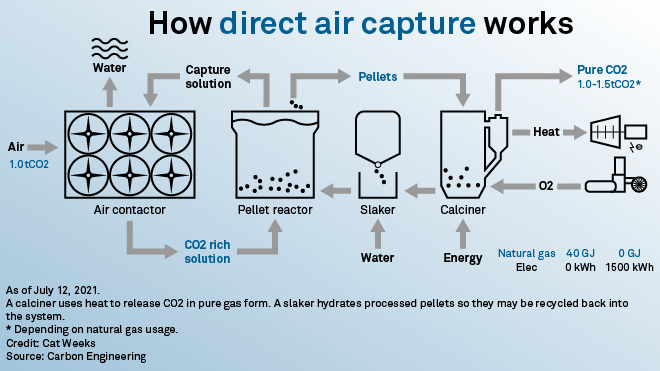The U.S. Department of Energy has launched a $3.5 billion program to support direct air capture of carbon dioxide emissions, a nascent technology that supporters say will be crucial to achieving national and global climate goals.
On May 19, the DOE issued a notice of intent to fund the program, which was created through the $1.2 trillion bipartisan infrastructure law that U.S. President Joe Biden signed in 2021.
"Removing legacy carbon pollution from the air through direct air capture and safely storing it is an essential weapon in our fight against the climate crisis," Energy Secretary Jennifer Granholm said in a release. The new program and other DOE initiatives funded by the infrastructure law will "help position the U.S. as a net-zero leader," she added.
Direct air capture, or DAC, technology separates carbon dioxide from ambient air before permanently storing the carbon underground or converting it to other products such as concrete.
According to the DOE, carbon dioxide removal must be deployed "at the gigaton scale" by midcentury to achieve Biden's goal for the U.S. economy to produce net-zero emissions by 2050. One gigaton of sequestered carbon equals the annual emissions of the U.S. light-duty vehicle fleet, or about 250 million cars driven in a year.

The $3.5 billion program will support four large-scale, regional DAC hubs, each of which will include a network of carbon removal projects. The hubs will be able to capture and store at least 1 million metric tons of carbon per year, from either a single or multiple units.
On the heels of the DOE announcement, two U.S. senators unveiled legislation to accelerate the deployment of carbon removal technologies.
Sens. Chris Coons, D-Del., and Sheldon Whitehouse, D-R.I., introduced the Federal Carbon Dioxide Removal Leadership Act on May 20.
The bill would require the DOE to enter into contracts for carbon removal using DAC or other related technologies, with the contracts to total 10 million tons annually by 2035. The proposal would also set a price ceiling for carbon dioxide removal of $150 per ton by 2035, including monitoring, reporting and verification.
Currently, most DAC facilities cost more than $500 per ton to operate, according to a summary of the bill.
"We know that federal procurement can play a key role in creating a market for much-needed [carbon dioxide removal] technologies, and this new legislation helps create that market and spurs innovation so that we can achieve net-zero emissions as soon as possible," said Matt Bright, carbon capture policy manager for the Clean Air Task Force, which promotes the deployment of low-carbon energy and climate technologies.
S&P Global Commodity Insights produces content for distribution on S&P Capital IQ Pro.



